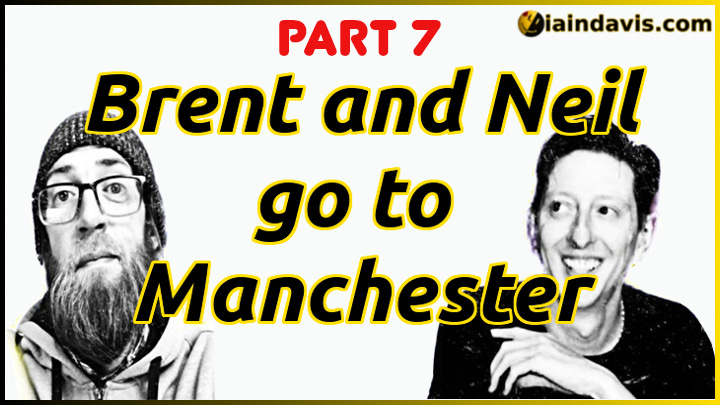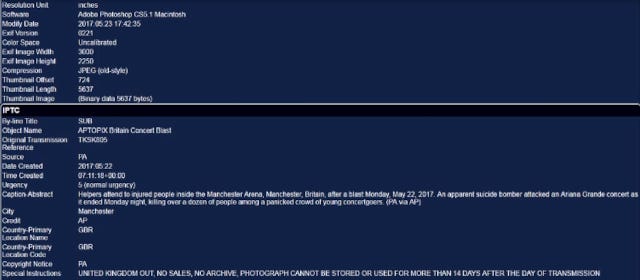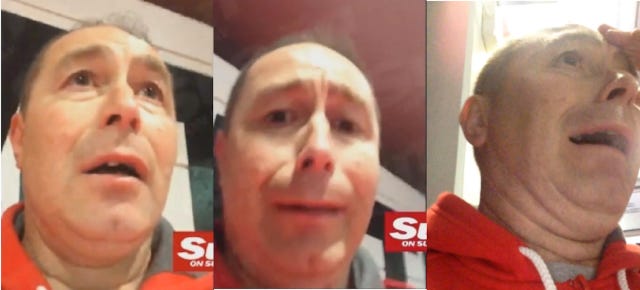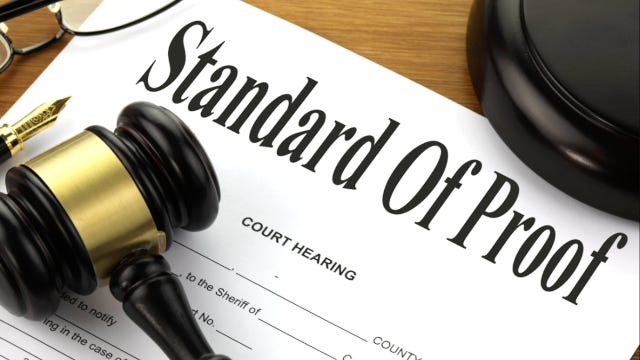*******************************************
I have not received any encouragement or inducement from anyone to write about or discuss any information related to the Manchester Attack. All research discussed is exclusively my own and based solely upon information freely available in the public domain.
*******************************************
Brent Lee and Neil Sanders have released their 8 part exploration of Richard D. Hall's Book and film called Manchester The Night of the Bang. You can download Richard's book For Free Here.
If you would like to support Richard's work you can also buy his Book HERE and HERE. If you wish, you can donate to support his ongoing legal battle HERE.
Before every Episode, Brent and Neil warn their listeners they will be discussing distressing material. I will be discussing the same and will include distressing images and video. Please do not read these articles if you are not prepared to consider such material.
**************************************
Let's continue to cover Brent Lee's and Neil Sanders' debunking of Richard D. Hall's theory that the alleged Manchester Arena bombing was a hoax. We have already established that it was a hoax and will proceed with that in mind.
More evidence may be revealed to challenge this firm belief. As it currently stands, the observable and audible physical evidence shows that the Manchester Arena bombing was a hoaxed false flag. No one could possibly have been killed or injured by a bombing that did not happen.
Episodes 6 - 8 of Brent and Neil go to Manchester contain the pairs' main debunking themes. Rather than follow the running order of the pairs’ debunk, we will focus upon specific aspects reported in Episodes 6 - 8.
Towards the end of Episode 6, Brent and Neil tackle the statement analysis of Genevieve Lewis that Hall used throughout his original book and film. Hall evidently considered SA a tool to inform his conjecture about what may have happened to the reported victims.
In 2020, when Hall published the original book and produced the accompanying documentary, the official Saunders Inquiry had yet to convene and the only "evidence" to support the official account was the Kerslake Report and a plethora of stories reported by the legacy media. The observable physical evidence Hall had at his disposal—revealed in the Parker photograph, the Bickerstaff video and the Barr footage—thoroughly contradicted the official narrative.
If the Parker photo and the Barr video were filmed in the morning before the bang, as Hall originally suspected, this was physical evidence demonstrating foreknowledge and fabrication. If the photo and the video were captured after the bang, which Hall later deduced, it showed only fabrication. The Bickerstaff video showed foreknowledge.
For more than three years after the bang, witness testimony, provided almost exclusively by the legacy media, told a story about a bombing that evidently did not happen. So it is understandable why Hall would have focused upon analysis of those witness statements.
Statement Analysis (SA), sometimes referred to as Scientific Content Analysis (SCAN), is admissible as trial evidence in countries including the Netherlands, Germany and Sweden. While it is not admissible in US courts, training is widely given but the extent its use by US law enforcement in investigations is unclear.
The SA process usually involves the analysis of text. Oral testimony is transcribed prior to applying SA techniques to the statement.
Brent and Neil correctly report that there is virtually no empirical foundation for SA. For example, an international team of psychologist conducted a very simple but pretty conclusive experiment. Their findings were damning for SA proponents:
[. . .] 117 participants were asked to write down one true and one fabricated statement about a recent negative event that happened in their lives. All statements were analyzed using 11 criteria derived from SCAN. Results indicated that SCAN was not able to correctly classify true and fabricated statements.
SA isn't the only widely used investigative tool that lacks an empirical basis. Hair analysis, dental impression analysis, lie detectors and more, are not based on any clear scientific evidence. Just as Hall used SA, these investigative tools assist investigation. They become more questionable when they are offered as claimed evidence to secure a conviction.
While many US law enforcement officers have undergone SA training, Sanders correctly identifies that the FBI-administered High-Value Detainee Interrogation Group conducted extensive testing of SA (SCAN) and determined:
When all 12 SCAN criteria were used in a laboratory study, SCAN did not distinguish truth-tellers from liars above the level of chance. Both gaps in memory and spontaneous corrections have been shown to be indicators of truth, contrary to what is claimed by SCAN.
Sanders also correctly highlights that Genevieve Lewis—the statement analyst Hall worked with—didn't appear to establish baseline speech pattern for the subjects (purported victims, their family members and witnesses) and seemingly did not account for regional dialects, etc.
To give just one example, in Episode 7 Neil Sanders discusses Lewis's analysis of the statement of Alex Klis:
This is the one: [. . .] "we were evacuated to a hotel and one of my mum's friends picked me up from Manchester and took us home."
In the book, Hall reported that Genevieve Lewis claimed:
I note a problem with pronouns which are instinctive and always reliable. Why is only she ["me"], picked up, yet “us” go home? There is something wrong here.
I agree with Brent's and Neil's observation. There is no indication of anything wrong with the statement. Alex Klis was a 20 year old Mancunian when she made that oral statement (later transcribed). The use of the word "us" is indicative of nothing more than regional dialect.
In my opinion, Sanders is also correct when he concludes, with regard to empirical justification, that SA "fails on every single level." However, this in no way substantiates Brent’s and Neil’s claim that Hall’s suspicions about some of the witness statements were unfounded.
Please go to 18:37 in this Richplanet video to see Hall’s discussion of the narrative that has been presented by reported Manchester Arena victim Martin Hibbert over the years.
For instance, in July 2017, just two months after the bang, Martin Hibbert told journalists at the Times:
I remember everything. [. . .] We had come out of the box and gone into the main auditorium. But I brushed shoulders with him, the terrorist, and the trajectory of that took me thankfully away from him. He was going in as we were coming out. We got about half-way down the auditorium, going towards the exit and that’s when the bomb went off.
This relatively fresh account is completely incongruous with the official narrative. Abedi supposedly detonated his bomb in the foyer—City Room—not the main auditorium—Arena.
Hall reported:
He [Mr Hibbert] is clearly implying here that he was inside the auditorium and that the bomb went off in the auditorium. This is not where the device went off. [. . .] It is clear that [in July 2017] Martin Hibbert believed that the blast had occurred inside the auditorium. Which is patently untrue.
In May 2018, Martin Hibbert’s story, reported in yet another legacy media interview, had changed. He still maintained he “brushed shoulders” with Abedi but the location had shifted to the City Room:
Heading out early meant we were in the foyer just as the bomber detonated himself. I bumped into him, actually. The police told me afterwards. Apparently as I rushed through some doors, you see us on CCTV coming together. A shame I didn't chin him, isn't it? A few moments later the explosion happened. It's hard to describe. The world just shook and boomed, and then there were screams, and you were no longer at a concert; you were in hell, really, a horror movie.
As we have already discussed, there is no observable physical evidence of the “horror” described by Martin Hibbert. Mr Hibbert referred to seeing CCTV footage—no one else has or will ever see—but what the police allegedly showed him doesn’t comport with the official narrative either.
Hall explained:
This amended claim still seems dubious because Abedi sat near the McDonald’s steps for a long period before walking into the centre of the foyer where he set off his device. He [Abedi] did not go near the City Room doors. Hibbert could not have come together with the terrorist as he went through the City Room doors.
Looking at these statements, we don’t need any knowledge of SA to be sceptical of Martin Hibbert’s account. We just need to be familiar with the evidence.
Richard D. Hall applied this same level of logical analysis to every witness statement he reported in his original book. He then used SA in an effort to augment that analysis. SA was not, as Brent and Neil claim, the entire basis for Hall’s interpretation of the witness statements. He already had reasonable suspicion they were deceptive.
Neil Sanders is also incorrect when, at the end of Episode 6, he claims that the majority of Hall's "case"—theory—is based upon SA.
Hall's theory is based upon observable, physically real evidence. Hall's appraisal of this evidence, showing the Manchester Arena bombing was a hoax, led him to investigate what happened to the reported victims. Ultimately, this was something of a fruitless exercise. Hall couldn't clearly establish what happened to them and, to this limited extent, published little more than speculation and outstanding questions.
Hall had already shown what did not happen to them. His use of SA to assist his further analysis added little in my opinion.
From 09:55 onward, in Episode 7 of Brent and Neil got to Manchester, the pair are able to successfully debunk various aspects of Hall's conjecture, speculation and posed questions. Their debunk covers a number of errors Hall made in his attempt to provide general scenarios potentially accounting for the alleged deceased and reported injuries.
In his original work, Hall's conjecture that various victims had "no ties" to their lives in the UK was based on some inaccurate, missing or partial information. Hall did not offer convincing evidence to substantiate some of his suspicions that reported victims may have fled abroad. His speculation about the possible estrangement of allegedly deceased victims, said to be in relationships, overlooked evidence to the contrary.
If we put these errors into perspective it is frankly remarkable that he made so few. The volume of evidence Hall investigated, examined and reported was immense. His diligence and careful cross checking to validate as much of that evidence as possible was impressive. Sure, he made some mistakes, but probably less than I have made in this comparatively tiny series of articles.
It is unfortunate, in my view, that Hall used SA to the extent that he did. Given his own ability to apply simple logic, in light of evidence, to witness accounts, I believe he could have foregone using SA. But what do I know?
In their successful debunk of SA and some of Hall's speculation, Brent and Neil cite Statement Analysis SCAN or Scam? by Robert Shearer. The duo quote Shearer:
[. . .] very unlikely or extraordinary claims should be met with extreme care and skepticism and must be supported by extraordinary evidence. Statement analysis is supported by personal testimony and anecdotal evidence that would hardly be considered "extraordinary."
Brent Lee and Neil Sanders presumably understand the relative value of sources used as evidence. They both recognise that personal testimony and anecdotes fall someway short of evidencing extraordinary claims. Please bear this in mind.
In a court of law there are different types of evidence. Broadly, primary evidence relates to physical objects, document or statements which can be proven to be relevant accounts of, or depict, real evidence. Secondary evidence is a copy of, or a statement about, the existence of primary evidence and is deemed less reliable. Forensic evidence is based upon the further, proven testing of primary and/or real evidence.
Real evidence can be defined as:
Physical ('real') evidence which can be produced in court and used by the judge or jury to come to a decision. Such evidence could include photographs, a knife or a weapon, a document, or audio tapes.
Real evidence is observable or audible fact.
Opinion, as opposed to observable fact, is not evidence. The exception to this is "expert evidence." While it remains opinion, it can be used in evidence if the court accepts that the expert is able to accurately advise the jury about complex issues that may be beyond the jury's collective knowledge or expertise but are relevant to the case.
Witness testimony—written or oral—needs to be believed, or rejected. There are many factors that contribute toward the credibility, or implausibility, of witness testimony.
Witness testimony is more plausible if it is substantiated by physical (real) evidence—observable fact. While less credible than testimony supported by observable fact, witness statements that correspond with secondary evidence—that attests to the existence of real or physical evidence—is more credible than witness testimony supported by neither.
Primary evidence is observable, physically real evidence that can be considered objective fact. A person seen lying on the ground in a photograph or video establishes the objective fact that a person was lying on the ground at the time and location captured by the photograph.
Primary evidence of shrapnel damage is only plausible evidence of a bombing if the provenance of that primary evidence can be established. If it is shown that the alleged shrapnel damage was not present in the immediate aftermath of an alleged bombing, we can deduce the “bomb damage” was incurred later and does not provide evidence of a shrapnel bomb. On the contrary, it then becomes primary evidence of fabrication.
Secondary evidence is a report or account attesting to the existence of primary evidence. A police report that shrapnel debris was found lying on the floor attests to the existence and location of shrapnel debris when it was found, not when it was put there. It is less convincing than a reliable photograph of that shrapnel demonstrably taken at a known time and location.
Witness testimony alone is not strong evidence of anything. The relative strength of witness testimony is dependent upon the degree to which it comports with primary and secondary evidence. This is what Hall was trying to establish in his original book and documentary.
Unlike Brent and Neil, whose goal has been to debunk Hall's theory that Manchester was a hoax, if we apply these standards of evidence to Hall's investigative reporting, and to Brent's and Neil's debunk, what can we deduce?
The primary, physically real evidence establishes the objective facts. The only clearly observable primary evidence we have is seen and heard in the Parker photograph, the Barr footage, the Bickerstaff video and the images and footage taken outside of the City Room and the Arena. The primary evidence establishes, as objective fact, that there was a loud bang that caused the crowd in the Arena to panic and stampede.
The CCTV stills presented at the Saunders Inquiry also provide some primary, physically real evidence. Redacted images, black blocks in CCTV stills and indistinguishable blurred blobs are not evidence of anything other than redaction.
Based on rational analysis of the accumulated real physical evidence observable in the Parker photo and the Barr footage we can deduce, as objective fact, that a powerful TATP shrapnel bomb did not explode inside the City Room of the Manchester Arena on the night of the 22nd May 2017. We can further deduce that nobody was killed or harmed because there was no shrapnel bomb.
Based on rational analysis of the accumulated real physical evidence, observable in the Bickerstaff video, we can deduce, as objective fact, that Bickerstaff filmed the footage before the bang. We can deduce some people involved in the events that transpired that night had foreknowledge of what was planned to occur. We can also deduce that crisis actors—Bickerstaff at the very least—were operating in the Arena that night.
Primary evidence was presented at the government inquiry showing structural damage, bomb fragments and debris in the City Room. This damage and claimed primary evidence was not present at the time when the Parker photograph and the Barr footage were recorded. We can deduce that the observed damage first occurred no sooner than four minutes after the bang. We can deduce that the primary evidence shown at the inquiry was fabricated to give the impression of a shrapnel bomb blast. We can deduce fabricated evidence was introduced to the official inquiry with the intention of manipulating the inquiry findings to support the official narrative.
We have primary evidence, shown in the CCTV stills at the inquiry, of a persistent flume of smoke—or something that appeared to be smoke—in the City Room that started sometime after the bang. There was no burning structure nor object to account for this apparent smoke. We can deduce that the smoke like substance was produced by some other mechanism and appears to be an attempt to give the impression of a bombing. Again, fabrication and an intent to mislead seems highly likely.
Primary evidence shows the physical condition of Ruth Murrell no more than four minutes after she reportedly had shrapnel blown through her thigh. This allegedly happened while she was stood next to Michelle Kiss who was said to have been killed by shrapnel from a bomb. The primary evidence of the CCTV still images shows that Ruth Murrell was not stood next to Michelle Kiss when the alleged bomb reportedly exploded.
The primary evidence does not support the claim that Ruth Murrell was injured in the City Room by a shrapnel bomb. We can deduce that the Ruth Murrell's story is not true and the primary evidence strongly suggests that Ruth Murrell was another crisis actor. Further, we can deduce that the reported circumstances of Michelle Kiss’ death are not true.
The primary evidence of CCTV stills shows four of the 22 people reportedly killed by a bomb in the City Room in the last few seconds immediately before the bang. Marcin Klis is potentially identifiable as one of the people seen lying on the floor in the Parker photo and the Barr footage.
Primary evidence established as objective fact that people were lying on the floor in the City Room within the first four minutes after the bang. Expert witness testimony, describing the anatomical destruction caused by a shrapnel bombs, established as an objective fact that the observable scene is not consistent with the immediate aftermath of a shrapnel bomb exploding in a crowd of people. We have no reason to suspect that any of the people seen lying on the floor have been harmed in any way by a shrapnel bomb.
In regard to the officially stated timing of the bang, the primary evidence is seemingly self contradictory. While we cannot deduce from this that the timestamps shown at the inquiry have been manipulated, when we consider the primary evidence demonstrating fabrication and manipulation, the likelihood that the timestamps were altered to suit the official narrative is high.
The official narrative of the Manchester Arena bombing is not consistent with the primary evidence. We have primary evidence showing the fabrication of evidence. We can deduce, with a high degree of certainty, that the official account of the Manchester Arena bombing is false and based upon fabrication. We can deduce that the findings of the Saunders Inquiry are false.
Primary evidence shows people panicking and fleeing the Arena. It shows a few people bleeding outside of the Arena. Again, expert witness testimony regarding bomb blast and shrapnel injuries enables us to deduce that this scene is not consistent with injured people fleeing a shrapnel bomb blast.
We have primary evidence showing that subsequent events outside of the City Room were not consistent with the detonation of TATP shrapnel bomb inside the City Room. The absence of blood trails at the exits, on the stairs and outside the Arena, the absence of physical injury consistent with a bombing, the absence of blood staining on any first responders and the absence of blood splatter or triage debris at the exits from the City Room combines to enable us to deduce that the scene outside of the City Room, and in the streets outside the Arena, was not consistent with a shrapnel bomb exploding inside the City Room of the Manchester Arena.
We have conflicting, witness testimony evidence. Some of that witness testimony is supported by primary evidence, some by secondary evidence and some by neither. Some of the secondary evidence presented at the inquiry cannot be accepted as secondary evidence because it does not comport with the primary, physically real evidence.
Witness testimony that is supported by the primary, physically real evidence is largely inconsistent with the official narrative. As is some of the witness testimony supported by secondary evidence presented at the inquiry.
Witness testimony indicates that a pyrotechnic device of some kind was placed against a wall in the City Room by Salman Abedi. This is not supported by either primary or secondary evidence. There are no observable scorch marks nor secondary reports of scorch marks. However, the claim is congruent with the primary evidence showing there was no shrapnel bomb.
Witness testimony describing bright light, fireballs, smoke, the smell of fireworks and the primary evidence of a bright flash—dash cam footage—supports the description of a pyrotechnic device, not a TATP bomb.
Witness testimony supported by secondary evidence—police reports—and congruent with primary evidence, indicates that Salman Abedi fled the City Room after placing the likely pyrotechnic device against the wall. Witness descriptions of his appearance when reportedly seen running with a backpack from the Audi and later fleeing the Arena, correspond with the primary evidence showing his physical appearance that night.
We have both primary, physical evidence and secondary evidence supported witness testimony showing that the driver of the grey Audi was later stopped at gunpoint by armed police. We cannot deduce from this that Abedi was the driver nor that the Audi was connected to the bang. All we have is a reasonable suspicion.
There is a considerable body of apparent secondary evidence, in the form of official reports, forensic reports, police records, autopsy reports and documentation—such as death certificates—which supports the official narrative. This evidence is voluminous and, in its totality, this alleged secondary evidence constructs a complex, interweaving story that convincingly describes a shrapnel bomb exploding in the City Room, killing 22 people and seriously injuring at least 38 more. There is considerable amount of this secondary evidence and comparatively little reliable primary evidence.
This secondary evidence, attesting to a suicide bomb detonating in the City Room at 22:31:00, is not supported by any of the reliable primary evidence. All of the reliable primary evidence contradicts the offered witness statements, reports and documents—including death certificates.
The primary evidence presented at the inquiry to purportedly substantiate the alleged secondary evidence was fabricated after the bang. The evidence offered to seemingly substantiate the official account fails the test to be considered plausible secondary evidence.
As the secondary evidence supporting witness testimony presented to the inquiry is not credible—it is contrary to the reliable primary evidence—what we are left with to substantiate the official narrative is uncorroborated witness testimony. The official account amounts to little more than claims, anecdotes and opinion. The primary evidence shows the most crucial elements of the State’s story about the Manchester Arena bombing are false.
In Episode 7 Brent and Neil try to convince their listeners that the official account is true by impressing upon them that there are a lot of witness statements. They highlight that the testimony provided at the inquiry was extensive and very detailed.
If you go over what they explained in the inquiry it is really detailed. [reading] "Marcin Klis and Angelika Klis arrived at the Arena at 6:30pm. They wandered around Manchester and took a selfie. CCTV shows the pair holding each others hands just before the bomb went off. [. . .] Paddy Ennis identifies them as deceased. 10.45 - Arena medic Ken O'Connor covers Angelika's face with a T-shirt taken from the merchandise stand and, at the same time, CCTV shows WPC Bullough stood near the bodies. At 10:50 PC Steven Cooke leans over Marcin's body and covers his face with a poster." The level of detail! I'm not going to do that for all of these [inquiry accounts] because it's more of the same.
Neil Sanders next discusses the primary physical evidence that he has seen and heard to convince him the stories he and Brent are reporting are true:
I haven't actually seen the CCTV footage, but there are so many people involved and so many timestamps, I realise, OK, that it would be grim to go through all of this. So does that seem fair if I say just trust me on this one. They [Marcin and Angelika Klis] are seen on CCTV at least nine times by various people. And not just on one camera but on various different cameras.
It does not “seem fair” to me to simply trust Brent and Neil. Claiming people were seen and photographic evidence exist, allegedly showing what happened, while simultaneously acknowledging you haven’t seen or heard any of it, is not convincing. From what little I know, Brent and Neil do not appear to have any evidence to substantiate their claims.
Brent Lee chimes in and says:
Absolutely! With the rest of this you can go and look at this yourself. You don't have to listen to us at all. You can go look at the inquest [inquiry] yourself.
Neil Sanders adds:
Yeah, if you go to the inquiry itself and then go to the actual court documents, for every single person that died, there is a massively detailed list, minute by minute, of where they were, who they interacted with, what happened. What injuries they sustained. You can find their autopsies. Well, not their autopsies but you can find the results of their autopsies.
Perhaps that was the case when Brent and Neil recorded their podcast, but now you can't go to the inquiry website because it has been removed. But even if you still could, all you would see are pictures inconsistent with the official narrative and a lot of blacked out, redacted nothing. You can also read a very detailed story comprised of lots of opinion and reports.
Based on oral and written anecdotes, which is practically all that is left, Sanders concludes:
There is more evidence to suggest that it happened than it didn't happen. Is Richard right? Do they prevent you from seeing this? Yes they do. But it is so detailed and there are so many people involved, that it just doesn't make any sense otherwise.
I do not accept that Brent’s and Neil’s findings—based on whatever “trust” they placed in the UK government’s account—are plausible. The logical fallacy of appeal to authority is not evidence of anything.
Given the observable, physically real evidence, reported by Richard D. Hall, we can deduce that Brent Lee and Neil Sanders are incorrect.
As intricate and as detailed as the official narrative may be, ultimately, it is just a story. Tolstoy's "War and Peace" has nearly 600,000 words in it. It provides us with a lot of descriptive detail and a complex narrative. The story Tolstoy tells, though interwoven with historical fact, is fiction.
Again, we return to Hall's theory:
My conclusion is simple. [. . .] The CCTV image evidence shows that the event was far more consistent with a staged attack than it was with a real terrorist attack where people were injured and died.
We can deduce, based upon all available evidence, that Hall is correct.
See you tomorrow for Part 8. Yes, we'll discuss the death certificate presented by Brent and Neil.










Why would the authorities stage this terrorist event? Was it to promote fear and division? (Just a wild guess).
Rat faced strawman with the boggley eyes and limp wrists says-
''So does that seem fair if I say just trust me on this one''
Every living thing in entire universe cries; 'NO, you sell-out- bullshitting goon !'
Jackanory for Jackasses and Jackals .